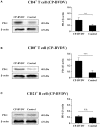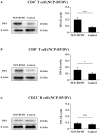PD-1-Mediated PI3K/Akt/mTOR, Caspase 9/Caspase 3 and ERK Pathways Are Involved in Regulating the Apoptosis and Proliferation of CD4+ and CD8+ T Cells During BVDV Infection in vitro
- PMID: 32256500
- PMCID: PMC7089960
- DOI: 10.3389/fimmu.2020.00467
PD-1-Mediated PI3K/Akt/mTOR, Caspase 9/Caspase 3 and ERK Pathways Are Involved in Regulating the Apoptosis and Proliferation of CD4+ and CD8+ T Cells During BVDV Infection in vitro
Abstract
Acute infection of bovine viral diarrhea virus (BVDV) is associated with immune dysfunction and can cause peripheral blood lymphopenia and lymphocyte apoptosis. Our previous study has confirmed that programmed death-1 (PD-1) blockade inhibits peripheral blood lymphocyte (PBL) apoptosis and restores proliferation and anti-viral immune functions of lymphocytes after BVDV infection in vitro. However, the immunomodulatory effects of PD-1 pathway on major PBL subsets are unclear and their underlying molecular mechanisms need to be further studied. Therefore, in this study, we examined PD-1 expression in bovine PBL subsets after BVDV infection in vitro and analyzed the effects of PD-1 blockade on the apoptosis and proliferation of CD4+ and CD8+ T cells and expression of PD-1 downstream signaling molecules. The results showed that PD-1 expression was enhanced on CD4+ and CD8+ T cells, but not on CD21+ B cells after cytopathic (CP) BVDV (strain NADL) and non-cytopathic (NCP) BVDV (strain KD) infection in vitro and PD-1 blockade significantly reduced the apoptosis of CD4+ and CD8+ T cells after these two strains infection. Remarkably, PD-1 blockade significantly increased the proliferation of CD4+ and CD8+ T cells after CP BVDV infection, but only significantly increased the proliferation of CD4+ T cells after NCP BVDV infection. In addition, we confirmed that PD-1-mediated PI3K/Akt/mTOR, caspase 9/caspase 3 and ERK pathways are involved in regulating the apoptosis and proliferation of CD4+ and CD8+ T cells during BVDV infection in vitro. Notably, ERK is involved in the regulation mechanism PD-1 mediated only when the cells are infected with CP BVDV. Our findings provide a scientific basis for exploring the molecular mechanism of immune dysfunction caused by acute BVDV infection.
Keywords: PI3K/Akt/mTOR pathway; bovine viral diarrhea virus (BVDV); immune dysfunction; lymphocyte; programmed death-1 (PD-1).
Copyright © 2020 Liu, Liu, Wu, Huang, Xu, Lian, Wang, Yue, Chen and Zhu.
Figures










Similar articles
-
PD-1 Blockade Restores the Proliferation of Peripheral Blood Lymphocyte and Inhibits Lymphocyte Apoptosis in a BALB/c Mouse Model of CP BVDV Acute Infection.Front Immunol. 2021 Sep 6;12:727254. doi: 10.3389/fimmu.2021.727254. eCollection 2021. Front Immunol. 2021. PMID: 34552590 Free PMC article.
-
PD-1 blockade inhibits lymphocyte apoptosis and restores proliferation and anti-viral immune functions of lymphocyte after CP and NCP BVDV infection in vitro.Vet Microbiol. 2018 Nov;226:74-80. doi: 10.1016/j.vetmic.2018.10.014. Epub 2018 Oct 15. Vet Microbiol. 2018. PMID: 30389046
-
PD-1 blockade synergizes with ascorbic acid to restore the activation and anti-viral immune functions of CD8+ T cells in a mouse model of BVDV infection.Vet Microbiol. 2025 Jan;300:110316. doi: 10.1016/j.vetmic.2024.110316. Epub 2024 Nov 24. Vet Microbiol. 2025. PMID: 39615163
-
The impact of BVDV infection on adaptive immunity.Biologicals. 2013 Jan;41(1):52-60. doi: 10.1016/j.biologicals.2012.09.009. Epub 2012 Nov 6. Biologicals. 2013. PMID: 23137817 Review.
-
[Bovine diarrhea virus: an update].Rev Argent Microbiol. 1997 Jan-Mar;29(1):47-61. Rev Argent Microbiol. 1997. PMID: 9229725 Review. Spanish.
Cited by
-
Anti-Cancer Effect of Chlorophyllin-Assisted Photodynamic Therapy to Induce Apoptosis through Oxidative Stress on Human Cervical Cancer.Int J Mol Sci. 2023 Jul 17;24(14):11565. doi: 10.3390/ijms241411565. Int J Mol Sci. 2023. PMID: 37511323 Free PMC article.
-
Host transcriptome response to Mycoplasma bovis and bovine viral diarrhea virus in bovine tissues.BMC Genomics. 2025 Apr 10;26(1):361. doi: 10.1186/s12864-025-11549-2. BMC Genomics. 2025. PMID: 40211134 Free PMC article.
-
PD-1 and PD-L1 Expression Levels as a Potential Biomarker of Chronic Rhinosinusitis and Head and Neck Cancers.J Clin Med. 2023 Mar 3;12(5):2033. doi: 10.3390/jcm12052033. J Clin Med. 2023. PMID: 36902820 Free PMC article.
-
Analysis of the fecal microbiome and metabolome in dairy cows with different body condition scores.PLoS One. 2025 Mar 10;20(3):e0319461. doi: 10.1371/journal.pone.0319461. eCollection 2025. PLoS One. 2025. PMID: 40063888 Free PMC article.
-
The gut microbiota contributes to the infection of bovine viral diarrhea virus in mice.J Virol. 2024 Feb 20;98(2):e0203523. doi: 10.1128/jvi.02035-23. Epub 2024 Feb 1. J Virol. 2024. PMID: 38299844 Free PMC article.
References
Publication types
MeSH terms
Substances
LinkOut - more resources
Full Text Sources
Research Materials
Miscellaneous

